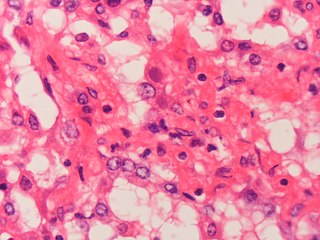
An asymptomatic carrier is a person or other organism that has become infected with a pathogen, but shows no signs or symptoms.

Bordetella bronchiseptica is a small, gram-negative, rod-shaped bacterium of the genus Bordetella. It can cause infectious bronchitis in dogs and other animals, but rarely infects humans. Closely related to B. pertussis—the obligate human pathogen that causes pertussis ; B. bronchiseptica can persist in the environment for extended periods.

Kennel cough is an upper respiratory infection affecting dogs. There are multiple causative agents, the most common being the bacterium Bordetella bronchiseptica, followed by canine parainfluenza virus, and to a lesser extent canine coronavirus. It is highly contagious; however, adult dogs may display immunity to reinfection even under constant exposure. Kennel cough is so named because the infection can spread quickly among dogs in the close quarters of a kennel or animal shelter.
Poultry diseases occur in poultry, which are domesticated birds kept for their meat, eggs or feathers. Poultry species include the chicken, turkey, duck, goose and ostrich.

Infectious bursal disease (IBD), also known as Gumboro disease, infectious bursitis, and infectious avian nephrosis, is a highly contagious disease of young chickens and turkeys caused by infectious bursal disease virus (IBDV), characterized by immunosuppression and mortality generally at 3 to 6 weeks of age. The disease was first discovered in Gumboro, Delaware in 1962. It is economically important to the poultry industry worldwide due to increased susceptibility to other diseases and negative interference with effective vaccination. In recent years, very virulent strains of IBDV (vvIBDV), causing severe mortality in chicken, have emerged in Europe, Latin America, South-East Asia, Africa, and the Middle East. Infection is via the oro-fecal route, with affected birds excreting high levels of the virus for approximately 2 weeks after infection. The disease is easily spread from infected chickens to healthy chickens through food, water, and physical contact.
Avian infectious bronchitis (IB) is an acute and highly contagious respiratory disease of chickens. The disease is caused by avian infectious bronchitis virus (IBV), a coronavirus, and characterized by respiratory signs including gasping, coughing, sneezing, tracheal rales, and nasal discharge. In young chickens, severe respiratory distress may occur. In layers, respiratory distress, nephritis, decrease in egg production, and loss of internal and external egg quality are reported.
Avian coronavirus is a species of virus from the genus Gammacoronavirus that infects birds; since 2018, all gammacoronaviruses which infect birds have been classified as this single species. The strain of avian coronavirus previously known as infectious bronchitis virus (IBV) is the only coronavirus that infects chickens. It causes avian infectious bronchitis, a highly infectious disease that affects the respiratory tract, gut, kidney and reproductive system. IBV affects the performance of both meat-producing and egg-producing chickens and is responsible for substantial economic loss within the poultry industry. The strain of avian coronavirus previously classified as Turkey coronavirus causes gastrointestinal disease in turkeys.
Marek's disease is a highly contagious viral neoplastic disease in chickens. It is named after József Marek, a Hungarian veterinarian who described it in 1907. Marek's disease is caused by an alphaherpesvirus known as "Marek's disease virus" (MDV) or Gallid alphaherpesvirus 2 (GaHV-2). The disease is characterized by the presence of T cell lymphoma as well as infiltration of nerves and organs by lymphocytes. Viruses related to MDV appear to be benign and can be used as vaccine strains to prevent Marek's disease. For example, the related herpesvirus found in turkeys (HVT), causes no apparent disease in the birds, and continues to be used as a vaccine strain for prevention of Marek's disease.

Adenovirus infection is a contagious viral disease, caused by adenoviruses, commonly resulting in a respiratory tract infection. Typical symptoms range from those of a common cold, such as nasal congestion, coryza and cough, to difficulty breathing as in pneumonia. Other general symptoms include fever, fatigue, muscle aches, headache, abdominal pain and swollen neck glands. Onset is usually two to fourteen days after exposure to the virus. A mild eye infection may occur on its own, combined with a sore throat and fever, or as a more severe adenoviral keratoconjunctivitis with a painful red eye, intolerance to light and discharge. Very young children may just have an earache. Adenovirus infection can present as a gastroenteritis with vomiting, diarrhoea and abdominal pain, with or without respiratory symptoms. However, some people have no symptoms.
An emergent virus is a virus that is either newly appeared, notably increasing in incidence/geographic range or has the potential to increase in the near future. Emergent viruses are a leading cause of emerging infectious diseases and raise public health challenges globally, given their potential to cause outbreaks of disease which can lead to epidemics and pandemics. As well as causing disease, emergent viruses can also have severe economic implications. Recent examples include the SARS-related coronaviruses, which have caused the 2002–2004 outbreak of SARS (SARS-CoV-1) and the 2019–2023 pandemic of COVID-19 (SARS-CoV-2). Other examples include the human immunodeficiency virus, which causes HIV/AIDS; the viruses responsible for Ebola; the H5N1 influenza virus responsible for avian influenza; and H1N1/09, which caused the 2009 swine flu pandemic. Viral emergence in humans is often a consequence of zoonosis, which involves a cross-species jump of a viral disease into humans from other animals. As zoonotic viruses exist in animal reservoirs, they are much more difficult to eradicate and can therefore establish persistent infections in human populations.

A subclinical infection—sometimes called a preinfection or inapparent infection—is an infection by a pathogen that causes few or no signs or symptoms of infection in the host. Subclinical infections can occur in both humans and animals. Depending on the pathogen, which can be a virus or intestinal parasite, the host may be infectious and able to transmit the pathogen without ever developing symptoms; such a host is called an asymptomatic carrier. Many pathogens, including HIV, typhoid fever, and coronaviruses such as COVID-19 spread in their host populations through subclinical infection.

Mycoplasma gallisepticum (MG) is a bacterium in the class Mollicutes and the family Mycoplasmataceae. It causes chronic respiratory disease (CRD) in chickens and infectious sinusitis in turkeys, chickens, game birds, pigeons, and passerine birds of all ages. Mycoplasma gallisepticum is a significant pathogen in poultry.

Influenza, commonly known as "the flu" or just "flu", is an infectious disease caused by influenza viruses. Symptoms range from mild to severe and often include fever, runny nose, sore throat, muscle pain, headache, coughing, and fatigue. These symptoms begin one to four days after exposure to the virus and last for about 2–8 days. Diarrhea and vomiting can occur, particularly in children. Influenza may progress to pneumonia from the virus or a subsequent bacterial infection. Other complications include acute respiratory distress syndrome, meningitis, encephalitis, and worsening of pre-existing health problems such as asthma and cardiovascular disease.
ATCvet code QI01Immunologicals for Aves is a therapeutic subgroup of the Anatomical Therapeutic Chemical Classification System for veterinary medicinal products, a system of alphanumeric codes developed by the World Health Organization (WHO) for the classification of drugs and other medical products for veterinary use. Subgroup QI01 is part of the anatomical group QI Immunologicals.
The avian immune system is the system of biological structures and cellular processes that protects birds from disease.

Egg drop syndrome '76 is a viral disease that affects birds, notably chickens, ducks, geese and swans. It is characterised by a sudden drop in production of eggs as well as its eggshell quality in apparent healthy laying birds.

The history of coronaviruses is an account of the discovery of the diseases caused by coronaviruses and the diseases they cause. It starts with the first report of a new type of upper-respiratory tract disease among chickens in North Dakota, U.S., in 1931. The causative agent was identified as a virus in 1933. By 1936, the disease and the virus were recognised as unique from other viral disease. They became known as infectious bronchitis virus (IBV), but later officially renamed as Avian coronavirus.
A nasal vaccine is a vaccine administered through the nose that stimulates an immune response without an injection. It induces immunity through the inner surface of the nose, a surface that naturally comes in contact with many airborne microbes. Nasal vaccines are emerging as an alternative to injectable vaccines because they do not use needles and can be introduced through the mucosal route. Nasal vaccines can be delivered through nasal sprays to prevent respiratory infections, such as influenza.
Vaccine resistance is the evolutionary adaptation of pathogens to infect and spread through vaccinated individuals, analogous to antimicrobial resistance. It concerns both human and animal vaccines. Although the emergence of a number of vaccine resistant pathogens has been well documented, this phenomenon is nevertheless much more rare and less of a concern than antimicrobial resistance.









